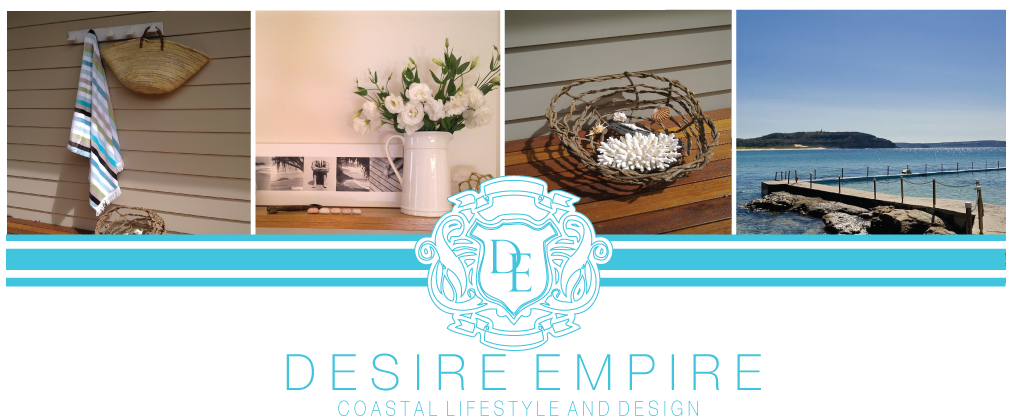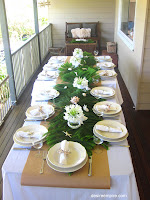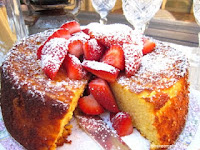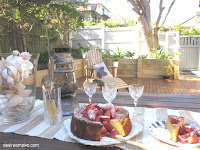
Hi All
Today is one of the most sacred holidays on the Australian calender. It is ANZAC day. ANZAC stands for Australian and New Zealand Army Corp. The legend of ANZAC was born in 1915 when Australia faced it's first battle as a nation, as the Allies planned to break the stale mate on the Western Front by taking Germany through the 'back door' via Gallipoli in Turkey. It was a complete baptism of fire, as it was a badly organised defeat. After that fiasco, the Australians were sent in 1916 to reinforce the Allies on the Western front in Northern France .
Several years ago we visited The Somme in Northern France and I have to say it was one of the best days of my life. It was only an hours train ride from Paris up to Amiens. I booked it all privately online, and sent my Euros off into the ether on trust. Our fabulous French guide Sylvestre, told us to be at the glass doors at Amiens station at 10am on that particular day. Sure enough we were and so was he. So much could have gone wrong, but nothing did. Next time we plan to spend a week up there. I recommend this day trip to anyone and a guide is probably the most efficient way to do it if your time is limited. If you make the effort, I promise you will be moved beyond belief and as it is so close to Paris it is so doable, even for just a day.
We all in this interiors blogging circle, know and love France for her beauty. She is the absolute pinnacle of style and elegance, but she has a dark history, that has shaped her people and ours and made us all what we are today.
I am starting at the end really, in Villers Bretonneux. As I write this thousands of Australians and French are gathering in that place to celebrate this decisive battle fought in 1918, which was the beginning of the end for the Germans.
As you can see from the map, Villers Bretonneux was the last town before the major roads and rail line at Amiens. Had the Germans got to Amiens, they were a short train ride into Paris. Their artillery was already within range of the outskirts of Paris at this point. But on 25 April 1918 it is no exaggeration to say that the Australians stopped them along this road. It was so decisive that the little primary school in Villers Bretonneux has a sign in it's playground that says 'Do Not Forget Australia' and a beautiful little museum which is an important stop on any tour of the Somme.
In 1918, the Germans were making one very big and successful push across Northern France in order to end the war. The Germans had regained much of the Territory won, at such a high human cost on both sides, by the Allies over the four years of the war and had pushed the Allies back from Belgium all the way back to the Somme in the first few months of 1918. So the fact they were stopped here at VB was the turning point to the Allies victory.
This tower I am standing on, is in the Australian war cemetery at Villers Bretonneux. The church spire on the horizon was were the Red Barron was shot down in 1918. It is disputed between the Australians and Canadians as to who shot him down, but he came down in the Australian sector of the front line so of course we like to claim that one.
The tower at Villers Bretonneux was used as a high post by the French in WW2, as the Germans came through again in 1939. Hilter with his Blitz Kreig, was able to do in 4 weeks what the Germans were unable to do in 4 years in WW1 and that was break through to Paris. Those are WW2 bullet holes from German fire you can see behind the boys.
This rectangular monument adorns the entrance to all Australian war graves across the world. It's curvature at the top is to the exact angle of the earth's surface. The idea is that it links all the war graves and the soldiers in them together.
 The Australians were known for their sense of humour and their inability to conform to military protocol. The Aussies named one of the main streets in the town of Peronne, Roo de Kanga, a deviation of Kangaroo, it is still named that today in their honour. They were larikins and may not have been able to salute officers and handle the military hierarchy of pomp and ceremony, but that is also what made them so tough and ingenious and so feared by the enemy.
The Australians were known for their sense of humour and their inability to conform to military protocol. The Aussies named one of the main streets in the town of Peronne, Roo de Kanga, a deviation of Kangaroo, it is still named that today in their honour. They were larikins and may not have been able to salute officers and handle the military hierarchy of pomp and ceremony, but that is also what made them so tough and ingenious and so feared by the enemy.Here the boys are lying in a shell hole at Mouquet Farm.
Mouquet Farm was another location, where the Australians had a terribly slaughterous and badly led defeat early in the war. So many wasted lives but they were still able to find some humour in it, referring to the area as Moo Cow Farm.
This German pill box was on the farm of our tour guide's grandmother. Thus he was able to dig it out and he had installed electricity so we were able to go down the first few steps into the bunker. The French understandably don't want to promote the area for it's war history. They just want to forget it. There are thousands of tunnels in this area, but most are on private land and have been sealed.
The Germans built such strong posts because in 1914 as they believed this was their new border with France. The Germans were very well dug in at the beginning of the war and that is why the Allies only gained such little ground for such huge losses. The heads thought that the artillery bombardments would debunk the Germans so the infantry could just jump over the trenches, walk across no mans land, and take the German held territory. But the German system of bunkers was so good, that apart from nerves due to the bombardment, the Allied artillery barely touched them. The artillery shells were inadequate to penetrate the concrete so the Germans were well protected underground during the Allied bombardments. The Allies were ordered to attack after these inadequate bombardments. As the Allies ran across no man's land they were mowed down by the German machine guns.
This pill box was on the border of the Australian and Canadian sectors, so our tour guide concluded that it had been captured by either of those two armies. The Allied helmet dug up by Sylvestre complete with bullet holes, a poignant reminder of what happened in that bunker as it was over run.
Inside the German Bunker. A very eerie feeling

This is another example of the German's ingenuity with concrete. This would have originally been the cellar to someones home. It was shored up with concrete and used as a German bunker on the front line at Pozieres in 1916.
The same German bunker as above, note the concrete pylons.
The fields of Pozieres, were Australians first saw action in France in 1916, Some 5000 Aussies were killed on the first day of fighting, here in these fields. At this stage of the war the Australians were under Allied command and not their own. The Generals commanding the battle, were several miles back. It all looked good on paper, with their flat maps and plans of attack. The communications were usually cut off early in the battle so the men were told to follow orders that were completely out of touch with the reality of what was occurring at the front. Asking men to do the impossible . That is cross open low ground under direct machine gun fire that the Allied artillery barrage had not dislodged.
Walking with dead bodies at Pozieres
The Australian memorial at Hamel, another great Australian victory in 1918, led by their own General Monash. It is interesting that this was the only war memorial the Germans destroyed in WW2 as they passed through Northern France in 1939, as it was originally an Australian solider bayoneting an eagle, a sacred German military symbol, which was a great insult to the Germans.
These trenches at Beaumont Hamel were perhaps the most moving of the day. The battalion that fought on this part of the front line was from Newfoundland in Canada. It was a complete slaughter for the same reasons that so many Australians were killed at Pozieres and Mouquet Farm, the Germans were very well dug in in Bunkers. The Canadians were told to just walk across no mans land toward the Germans. This was the complete naivety of their orders and 85% of the battalion was killed in the first 15 minutes of the battle.
The only good part in this story, is that the Canadian Chaplin from this battalion returned after the war to negotiate with 250 different land owners to purchase their land, so that it could be retained as a memorial to that disastrous battle. These are some of the only trench systems remaining in Northern France, thanks to the foresight of that Chaplain.
You can just make out the moose in the centre, at the top of the Canadian memorial at the top of the monument. The reason the trenches are roped off, is because there are so many unexploded shells. In Northern France some 35 people are killed or injured annually by exploding shells.

Here are some shell casings collected and piled up in a suburban backyard.
This was a German war grave we visited, an equally haunting place.
Well dear reader, thanks for coming this far with me. I hope you have learned something and enjoyed your little trip to the battlefields of Northern France.
Best Carolyn
Today I am linked up to











































































































I certainly enjoyed this Australian history in the WWs'in France. What a tragedy that exploding shells are still killing people to this day. Great photos. You did a good job explaining what happened there.
ReplyDeleteThank you so much for this post Carolyn. My Grandfather fought at Paschendale so it was wonderful to see your photos. I would love to visit one day and see it for myself. ;)Sharyne
ReplyDeleteWhat an interesting post. Your photos and description of what took place were enough to keep me reading through this informative piece. Very moving to say the least. Thanks.
ReplyDeletemy great uncle was there and my partner lived and worked in the area. such a waste of life. thinking about everyone who suffers because of war today.
ReplyDeletecheryl x
what a great and moving history, thanks for the virtual tour, you took lovely photos.
ReplyDeleteI'm following you from HomemakeronaDime Creative Bloggers' Party and Hop.
Susan @ http://tea-diary.blogspot.com
Beautiful photos and great piece of history to know about. Thank you for sharing--have a great week. Patty
ReplyDeleteWow, what an incredibly special trip....thank you so much for sharing. It is something that will stay with you forever I'm certain. xo
ReplyDeletelearnt a new history and loved ur snaps...
ReplyDeleteDear Carolyn,
ReplyDeleteThank you for sharing this amazing trip with us on ANZAC day...Having grown up in Albany Western Australia, we are taught much about the ANZACs and their final days training on Australian soil before shipping out, and though we are also told what they faced once they left, your photographs and descriptions have given it "a face" so to speak.
I am so grateful that my grandfather served in New Guinea and was not slaughtered in Europe like so many of our boys.
Thank you again for sharing.
Blessings Kelsie
Carolyn, what a fabulous share of history & the photos to blend with it. Beautiful land, lovely people, history never to endure again.
ReplyDeleteThank you for learning more than I knew.
Have a beautiful week ~
TTFN ~
Marydon
Much was lost by your brave soldiers. I am impressed by how well versed in history you are. Thank you for this interesting post and may we never forget. ♥O
ReplyDeleteThank you for sharing the history and photos of your trip. It's beautiful there.
ReplyDeleteBeautiful beautiful post Carolyn! And gorgeous family photos too!
ReplyDeleteVery interesting and moving - thanks for sharing Carolyn.
ReplyDeletexo Cathy
Such a special and interesting post. History that most of us aren't familar with. Beautiful pictures. Thanks so much for joining TTT. Hugs, Marty
ReplyDeleteCarolyn, thanks for sharing some bits of history. Those pictures are stunning :) Really appreciate you sharing this great post with us at the Creative Bloggers' Party & Hop.
ReplyDeleteI really enjoyed your trip. Thank you for sharing and I hope to do a similar trip one day. Cheers!
ReplyDelete